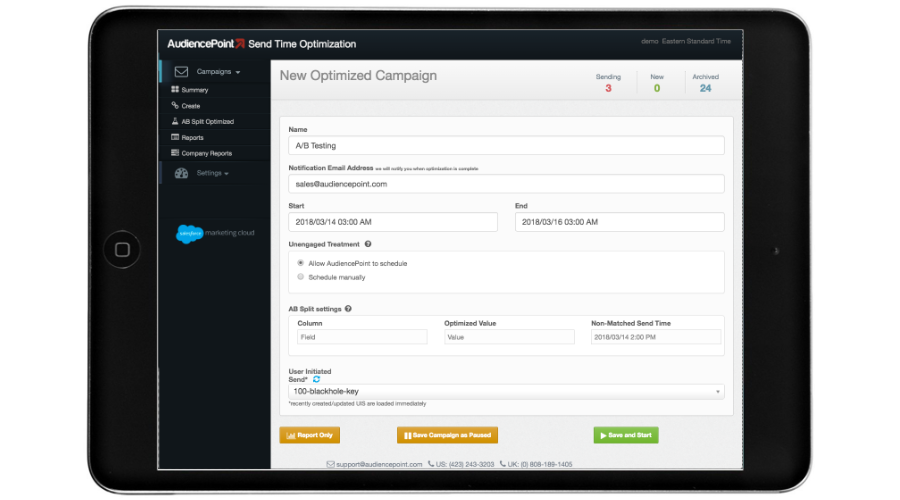In email marketing nothing is more important than making sure your subscribers get your emails. Understanding email deliverability...
An important aspect of improving email campaigns is tracking and analyzing data to see how your emails performed. One of the best ways to understand email performance and make improvements is to track key performance indicators (KPIs), which are email engagement metrics that are key to the success of an email campaign.
If you’re wondering how to efficiently track this data, a KPI dashboard can help. This article will tell you what you should know about KPI dashboards and offer resources that will help you get started tracking your email marketing efforts.
What Is a KPI Dashboard?
KPI dashboards, also referred to as email metrics dashboards, are used to efficiently organize the most important data from marketing emails. Email marketing analytics tools that provide KPI dashboards will allow you to pick the metrics that are most important to your company’s needs to give a quick overview of email performance.
KPI dashboards typically take up the span of one page, so you can easily digest key metrics you’re tracking and efficiently adjust your email marketing strategy. One of the best ways to track email marketing KPIs is through AudiencePoint.
AudiencePoint’s email insight software takes key metrics from email campaigns a step further by giving you actionable ideas for how you can adjust your strategy and get better results. AudiencePoint will track the activity of your subscribers across their inboxes, so you can have the data you need to better target your audience, (such as the best time of day to send an email.)
What Are the KPIs for Email Marketing?
There are a lot of KPIs that can be tracked for email marketing. While having a lot of data is great, it can feel overwhelming if you don’t know what it means or what’s most important for you to track. This is why a KPI dashboard that organizes essential metrics can be extremely helpful. Some of the most common KPIs for email marketing are:
- Click-through rate: Click-through rate measures the percentage of recipients who click a link within your email. This is an important metric to see how successful your call to action was and how engaging your content was for subscribers.
- Conversion rate: Email marketing conversion rate measures the percentage of recipients who take a targeted action after reading your email. This is an important metric to most companies, since conversions are commonly measured in sales, along with other important actions like app installs, or starting a free trial.
- Unsubscribe rate: Unsubscribe rate tracks the percentage of recipients who unsubscribe from your email list after seeing your email. A large percentage of unsubscribes can indicate that your content isn’t living up to expectations or that people are receiving emails from you when they don’t want to.
- Bounce rate: Bounce rate tracks the percentage of emails that aren’t accepted by receiving domains. High bounce rates can indicate invalid email addresses that should be removed from your email list. Consistently low engagement can also cause emails to start bouncing, which is why tracking and improving KPIs is essential.
- Open rate: Open rate in email marketing measures the percentage of email opens out of the total number of emails delivered. This is a key indicator of your subject line’s effectiveness and how receptive subscribers are to receiving emails from you. However, open rate has become more difficult to accurately track due to Apple’s mail privacy protection (MPP).
A KPI dashboard for email marketing can help you track all these essential metrics and more in an organized way, which makes it a great tool for improving email performance.
How Does a KPI Dashboard Help with Email Marketing Performance?
A KPI dashboard will help you improve email marketing performance by efficiently tracking and organizing the data that’s most important to your business. Email KPI dashboards can be tailored to specific goals like increasing subscriber engagement, getting more sales through emails, or improving email customer service efforts.
You can even create KPI dashboards for different sections of your business to help manage various aspects and goals you are looking to achieve. Efficiently getting insights into the most important metrics and how they affect email performance helps busy business owners or marketers take actionable steps to make improvements without a lot of hassle or guesswork.
Examples of KPI Dashboards in 2023
Some examples of KPI dashboards that can be used for email marketing in 2023 are:
- Sales dashboard: Many companies will be interested in a sales dashboard, since that is typically one of the primary goals of email marketing. Sales KPI dashboards track key metrics like conversion rate, return on investment (ROI), revenue per email, and revenue per subscriber.
- Subscriber engagement dashboard: An email subscriber engagement dashboard helps you track key data about how subscribers interact with email content. Common KPIs for subscriber engagement are click-through rate, open rate, and email forwards or shares.
- Customer service: Companies who provide customer service through email will be interested in KPIs for resolving inquiries efficiently. Common customer service email KPIs are customer satisfaction score (CSAT), first response time, tickets solved, and resolution time.
- Growth dashboard: An email marketing growth dashboard will track the success of your efforts to grow your list and retain subscribers. Common KPIs for email list growth are the number of subscribers, list growth rate, and unsubscribe rate.
As you can see, many different KPI dashboards can be created based on what you are trying to improve. If you want to get started tracking KPIs and work on improving your email campaigns, AudiencePoint can help.
How AudiencePoint Can Help You with Email Marketing
AudiencePoint’s email insight software provides a streamlined platform with tools that are easy to implement to track data and optimize your email strategy. This helps take the hassle out of email marketing for marketers and business owners by providing simple and actionable ways to improve email campaigns.
AudiencePoint’s tools will help you optimize send times and get insights into how your subscribers interact with your content. These insights will help you send more engaging emails, segment your email list, re-engage inactive subscribers, and improve the areas of email marketing that are most important to your needs.
If this sounds like it would benefit your business, contact us for more information about how AudiencePoint can help you.




